The energy used in institutional, commercial, and industrial buildings in cold climates (zone 4 and above) is substantial. Most of this energy is used after construction is complete; hence, reducing the operational energy use and increasing durability should be the prime concern of those who wish to design and build "green" buildings. This digest discusses the ten strategies that will have the greatest impact, based on experience with successful buildings, modeling, and the literature in the field.
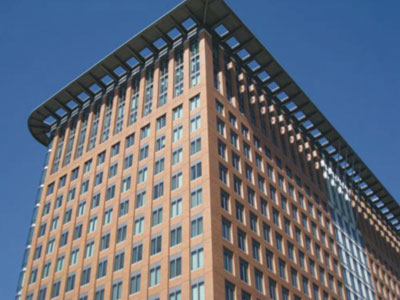
Figure 1: A large modern office tower with highly efficient shape and window-wall areas.
Low-energy buildings are more than buildings with high-performance enclosure assemblies – many other design choices are required, especially for mechanical system design, lighting, and controls. Excellent mechanical systems can be combined with mediocre enclosures to produce a better-than-average building. An exceptional enclosure with poor mechanical systems or controls can also produce an acceptable building. Great buildings, buildings that can reach towards net-zero energy performance, require both a very good enclosure and very good mechanical systems and controls.
However, in modern buildings, the enclosure’s performance almost always has a greater impact on energy use than any other building component. In fact, it is almost impossible to conceive of a low-energy consumption building (and all net-zero energy buildings must first be low-consumption buildings) in a cold climate that does not have an exceptional building enclosure. The enclosure is also implicated in the majority of building durability problems, legal claims against design and construction teams, and a host of comfort and health problems.
Generally, then, for most institutional, commercial and industrial buildings in cold climates, the smart way to approach energy efficiency is to start by addressing the building enclosure design. Then you should select approaches to ventilation, heating and cooling, and lighting. The choices one should consider and make in a building design process usually should be prioritized by both impact on building performance and cost. Some choices are both low cost and high impact – these are naturally high priority. Other choices are important to make early in design because they either empower future important decisions, or remove potential obstacles later in the design process.
This multitude of advice can be boiled down to the top ten strategies2 outlined below based on experience with successful buildings, modeling, and the literature in the field. In most situations, only when this list has been fully explored and the practical options implemented, should renewable energy from on-site sources (photovoltaic, combined heat and power, etc.) be added to reach lower energy targets such as Net-Zero Energy or Net-Zero Carbon targets3.
1. Limit window-to-wall ratio (WWR) to the range of 20-40%, 50% with ultra-performance windows.
Windows should clearly be considered first: in terms of importance to energy consumption, the window-to-wall ratio (WWR)4 and window performance are likely the most significant decisions for a low-energy commercial or institutional building (Figure 2). Contrary to the belief of some, highly-glazed buildings (WWR>40%) in cold climates do notsave more daylighting energy than they lose in heat. Large swaths of south-facing windows also rarely collect more useful free heat during the day than they lose at night. These are myths of a by-gone era where lights were very inefficient, and passive solar heating rules were still based on moderate, sunny climates in the US Southwest.

Figure 2: The window-to-wall ratio dramatically influences the ability of the overall vertical enclosure to resist heat loss.
Given that modern commercial windows typically have overall (including frame) U-values of about 0.4 (R-2.5), and that walls can easily have R-values of 15, the disproportionate effect of window area can readily be appreciated. Such a combination would meet the ASHRAE 90.1 code and yet the overall average R-value is only R-5. High-performance glazing, i.e. systems with a U-value of less than 0.2 (R-5), can allow for higher window area with no energy penalty.
Numerous studies of commercial buildings have shown that the optimal WWR for energy performance centers around 25-35% in cold climates5. However, the window area ratio is normally driven by the need for views, connection to the exterior, and quality of natural light, not energy use. As in most engineering analysis, the optimum area is a “flat” curve, meaning other design factors can allow the WWR to move to either side of the optimum with only small negative impacts on performance.
2. Increase window performance (lowest U-value affordable in cold climates, including frame effects).
Heat flow through windows and curtainwalls is measured using the U-value. Today’s best-available commercial double-glazed windows, i.e., low-e coated, gas-filled units with fiberglass frames, can readily be procured with U-values of less than 0.3 (R-values over 3.3, USI 1.7 W/m2K). Triple-glazed fiberglass frames with U-values under 0.15 (USI0.8 W/m2K, R-7) are available for truly high performance. Triple-glazed units, especially with low-e coatings and gas fills, are almost always justified for low-energy buildings in climate zones 7 and 8, and as far south as zone 5. Alas, aluminum-framed windows and curtainwalls rarely achieve these performance levels: U-values of less than 0.35 (R-values over 2.8, USI 1.9W/m2K) for double-glazed and 0.25 (USI1.4 W/m2K, R-4) for triple-glazed units are often the best performance locally available.
To avoid unplanned heat loss through frames it is important to ensure two things: first, that the thermal control of the window frame (the thermal break) is aligned with the thermal control layer of the wall (normally the insulation layer, as in Figure 3); second, that open frames are airsealed on both sides or (preferably) filled with low-expansion foam or pre-formed insulation inserts (Figure 4).
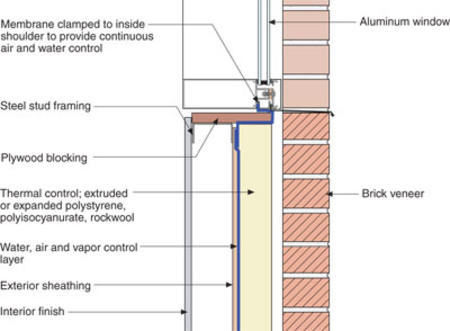
Figure 3: Aligning the thermal control of the window frame (i.e., the thermal break) and IGU with the thermal control layer of the wall (insulation) is important to avoid thermal flanking.
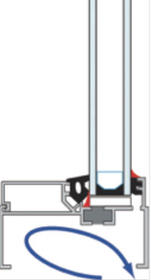
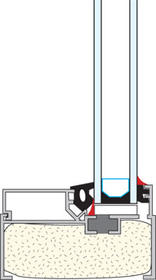
Figure 4: Open window frames can allow air to enter and bypass even the limited thermal resistance of the frame. Filling the frame with low expansion foam on site, or, preferably, performed insulation in the factory, minimize this impact.
3. Increase wall/roof insulation (especially to control thermal bridging) and airtighten.
Increasing insulation is perhaps an obvious step in improving energy efficiency. However, where the insulation is added in an assembly is just as important as how much: in many modern commercial enclosures, the majority of lost R-value is due to thermal bridging around insulation6. Air leakage through enclosures can similarly bypass insulation and render it effectively useless.
In commercial and industrial buildings, steel framing and concrete block masonry are common assembly types and are prone to serious thermal bridging; when insulation is added only between studs or within the voids in concrete blocks, heat easily travels (or “bridges”) around the insulation, through the steel or concrete, and via floor slab penetrations. As new codes and standards are developed and widely adopted, continuous insulation, or “ci,” will become the standard approach, as only ci insulation is all or mostly effective R-value.
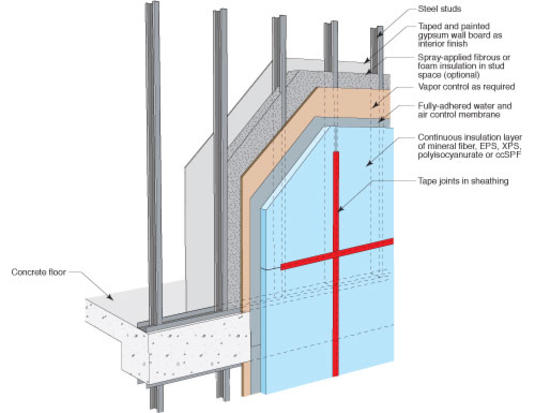
Figure 5: Exterior insulation can be installed in a continuous and essentially unbroken blanket, ensuring the effective R-value is close to that specified.
Little benefit is derived from insulation installed within the framing of a steel stud wall, where thermal bridging through the floor slabs and studs will reduce R-13 to R-19 stud bay insulation to an effective R-5 or R-6. Adding 7” of R-6/inch insulation to the hollow voids of a 10” concrete masonry wall will provide an effective insulation value of only approximately R-5 to R-7 in most applications. A major advantage of continuous exterior insulation, especially in steel and concrete enclosures, is the blunting of thermal bridges at floor structures. Simply adding thickness to the exterior continuous insulation layers allows one to reach very high true R-values and reduce condensation risks. In some cases the modest additional R-value gained from studspace insulation may justify the risk and effort of installing it.
Airtightness is important not just to reduce heat loss and gain, but also to ensure good indoor air quality, avoid condensation of water vapor (due to warm humid air flowing across an enclosure and condensing on cold surfaces), and for comfort reasons (i.e. avoiding drafts and blocking sound and odors)7. Special-use buildings such as hospitals and museums may require higher indoor RH in winter months, and will therefore require very high levels of airtightness and pressure control to avoid condensation problems.
4. Separate ventilation air supply from heating and cooling.
Compared to residential buildings, commercial and institutional buildings often need to move much larger quantities of energy for heating and cooling. The fans required to move air that moves energy (heat or cool) round a building consume significant amounts of energy in large buildings. Typically, large ducts are also required, which drive the demand for large inter-floor spaces and multiple penetrations between different occupancy and fire separation zones. This practice causes all kinds of unnecessary expense, performance problems, and excess energy use. Minimizing the amount of air moved around buildings can best be achieved by separating heating and cooling from ventilation and dehumidification. This decision results in much more robust, easy-to-control, and energy efficient systems8.
A dedicated outdoor air system (DOAS) should be used to provide ventilation and avoid the too-common indoor air quality problem of re-circulating polluted air from one space or occupancy to another. DOAS save energy because they only move air for ventilation, which is a modest volume, and only move air when ventilation is needed, not when heating or cooling is needed.
To provide heating and cooling only to each zone or occupancy a number of systems can be used. Local air-based systems are not far from the energy optimum provided that the ducts are short and the pressure drops are small. For example, low-velocity fan coil units with dry coils and ECM motors that take air from the space and mix conditioned air back into the space are now available. Valence cooling and baseboard heating are other options, as are the increasingly popular efficient Variable Refrigerant Flow/Volume (VRF / VRV) systems.
5. Use occupancy and daylighting controls for lights and equipment.
Although daylighting will not save enough energy to justify high WWRs, daylight harvesting and lighting controls will almost always be justified for low-energy buildings and can significantly reduce lighting energy use. However, daylighting design by itself is not enough to save energy, because occupants regularly leave lights on even if daylight increases to sufficient levels, and certainly when they exit a room. Hence, to realize lighting energy savings, occupancy and even lighting level sensors are needed. Other equipment may need to stay on all or most times (ventilation, for example, should always be running at a low level in order to remove building-generated pollutants), but can be adjusted to proper levels using automated occupancy controls.
6. Reduce equipment/plug & lighting power densities.
This strategy is pretty straightforward: install less equipment and more efficient equipment. Codes have mandated lower installed lighting power densities (LPD), but good lighting design and efficient fixtures can reduce LPD’s further. As lighting becomes more efficient, other loads, such as routers, servers, multiple monitors, and unregulated desktop lighting become dominant energy users in some types of occupancies.
To address these loads, designers must carefully evaluate the projected and likely uses of each of the spaces and often engage with users to make decisions about office or IT equipment that have not previously been part of building design. Common examples include the selection of laptops vs. desktops and the use of more energy-efficient cloud servers vs. rackmounted units in closets. For very low-energy buildings, this level of design integration is almost always necessary.
7. Don’t over-ventilate, and use heat recovery & demand controlled ventilation.
Although ventilation should be separated from heating/cooling (see Strategy #4), ventilation air must still be heated or cooled for occupant comfort. Heat Recovery or Energy Recovery reduces the energy needed for this purpose by transferring energy (and moisture in the case of ER) between the supply and exhaust streams. Ventilator units also provide the fans needed to move the air, and most DOAS units also contain heat or energy exchangers.
An important, and usually low-cost, strategy is to control ventilation so that it is only provided when needed. It is far too common that empty classrooms, hallways, auditoriums, meeting rooms, etc. are over-ventilated when empty. Happily, the problem of over-ventilation can be addressed through Demand Controlled Ventilation (DCV), a system that uses CO2 and/or occupancy sensors to adjust the level of ventilation to the occupancy and activity level in a space. A DVC system combined with a DOAS and separate heating/cooling system as described above is strongly recommended for large multi-zone commercial and institutional buildings9. It is the most energy efficient way to reliably provide fresh air and routinely is shown to be the lowest energy use strategy for mechanicals systems in almost all types of occupancy (e.g., more efficient than VAV, CAV, etc.).
8. Improve boiler and chiller efficiency & recover waste heat
Modern boilers and chillers are often efficient. However, for low-energy buildings, it is often worth selecting the best-in-class or close to it for these primary units. For example, natural gas boilers with 92 to 96% efficiency do save non-trivial amounts of energy relative to more commonly-selected 82-88% efficient units. Mid-size water-cooled chillers can have integrated part load efficiencies (IPLV) of as low as 0.3 kW/ton (a COP of 11!), rather than the ASHRAE-minimum 0.6.
However, the system into which a boiler or chiller is integrated is at least as important as the unit itself. There are no high-efficiency condensing boilers available that can achieve high, i.e. 95%, efficiency if they are not installed in a system that returns water below about 120 °F / 50 °C. There are also boilers rated at 92% that can easily outperform units rated at 96% if the latter are fed return water at high temperature and the former are fed cooler water (such as from radiant floors or low-temperature fancoils). Even more critical to energy use is the system into which a chiller is integrated. Many a high-efficiency chiller or ground-source heat pump has not met the hopes of low energy use because of excess pump and fan energy caused by bad selection, poor control, small pipes and ducts, and other design issues. Hence, keeping a sharp eye on system energy performance under the likely operating conditions is far more important than selecting the most efficient units.
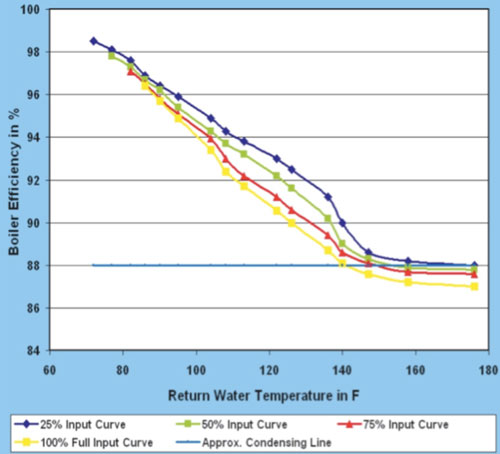
Figure 6: Efficiency curve for a high-efficiency natural gas boiler. The return water temperature
from the heating loop has a very important impact on the potential efficiency.
Modern buildings still throw energy away. Heat recovery systems should always be evaluated to discover where energy is being discarded. A common example is the server room or telecommunications closet: these spaces often require cooling because of the high density of electrical devices, and usually have specialized cooling systems. Rather than selecting a system that rejects this heat to the outdoors even in the middle of winter, heat pump systems that use this heat for some good purpose should be considered. A commonly successful approach is to use the heat from the server room to preheat the domestic hot water in the building, a heat load that is pretty constant over the year. Heat recovery chillers dedicated to the center core of commercial buildings (i.e., zones that require cooling all year) should be used to direct the collected heat into a hot/warm water loop, where it can be used to heat the perimeter during cool hours, or be rejected to the outside during hot hours.
9. Use variable speed controls for all large pumps and fans. Implement low-temperature hydronic heating and cooling where appropriate.
Variable speed controls (or Variable Frequency Drives, VFD) are now widely available, and should be used for any reasonably sized pump or fan (e.g., over 2 to 5 HP) that is expected to experience widely varying demand. For smaller pumps and fans, multiple speed ECM motors provide the same benefits at lower cost and complexity, and are finding their way into even 1/6 HP fan-coil motors. However, do NOT waste money and resources on variable speed controls for pumps and fans that are unlikely to see much variation in load: a too-common, wasteful practise is to use VFDs to commission a fan or pump, rather than use different sheave sizes for the proper rate of flow.
Moving heat and cold around a large building consumes a significant amount of energy. Using air to move this energy carries a significant energy potential. Using hydronic systems for cooling and heating, or refrigerant (VRF or VRV systems) results in more and more energy savings (less pumping and fans); as the size of the building and the quantity of energy increases, the superiority of non-air systems increases.
Finally, ultra-low-energy buildings will often use hydronic systems operated at a low temperature difference, e.g., using water temperatures of just 80 °F/27°C for heating and 67 °F/19°C for cooling. A low-differential temperature, or low energy10, strategy allows for the use of the most efficient condensing boilers, harvesting low-temperature waste heat and active solar heating, and direct and indirect evaporative cooling (aka “water-side economizers”), “free” ground cooling, etc.
10. Use a simple and compact building form, oriented to the sun, with a depth that allows daylight harvesting.
Building form and orientation do not have as large an impact on energy consumption as sometimes thought, especially for mid-size or large buildings11. In all buildings, the ratio of enclosure area to floor area is important, and hence simple shapes are preferred (as well as being less expensive to build and maintain).
The impact of building form on total energy consumption is less for larger buildings than small ones. In many cases, a long, narrow “bar” shape is appropriate – the increased energy losses due to a less-than-ideal non-square form can be off-set by increasing the performance of the enclosure, and by using daylighting and natural ventilation strategies, which this shape allows.
A useful metric for commercial buildings is the ratio of the usable floor area, F, to above-grade enclosure area, E. Simpler, more compact forms have higher F/E ratios and hence are preferable (see Figure 7). It should also be noted that higher F/E ratios mean more usable/rentable space for the same building enclosure cost. More expensive building enclosures on a per area basis can actually be less expensive on a per rentable/saleable square footage basis if a compact form is used.

Figure 7: Impact of form on floor-to-enclosure (F/E) area ratio of different building types.
If at all possible, the building should be oriented towards the south (allowing useful winter solar gain while easily rejecting summer gain and minimizing exposure to hot west summer sun). For daylighting, the maximum depth will be 2 to 2.5 times the head height of the windows – so, for most office buildings, offices on either side of a double-loaded corridor/core can be daylit if the building is about 36 – 50 feet deep12, plus the corridor/core width. Tight sites and dense coverage will often result in E and H plan-shaped buildings with most of the benefits of a simpler bar.
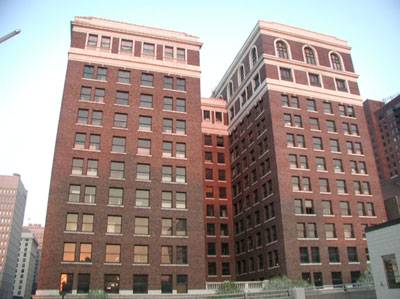
Figure 8: Tight sites with high density do not have to sacrifice daylighting and view.
High Performance Enclosures: Design Guide for Institutional, Commercial and Industrial Buildings in Cold Climates explores these ideas further, primarily as they relate to the enclosure.
References
ASHRAE. Handbook of Fundamentals. American Society of Heating, Refrigerating and Air Conditioning Engineers, Atlanta, 2009.
Bodart, M., De Herde, A., “Study of Parameters and Criteria Influencing the Choice of Glazing in Office Buildings in Belgium”, Proc of DOE/ASHRAE Buildings III, Clearwater, FL, December 2001.
Carmody, J., S. Selkowitz, E.S. Lee, D. Arasteh, T. Wilmert. Window Systems for High Performance Commercial Buildings. New York: W.W. Norton and Company, Inc., 2004.Cole and Kernan, “Life-cycle energy use in office buildings,” Building & Environment, Vol. 31, No. 4, pp. 307-317, 1996
Johnson, R., Sullivan, R., Selkowitz, S., Nozaki, S., Conner, C., Arasteh, D. “Glazing energy performance and design optimization with daylighting.” Energy & Buildings, Vol. 6, No. 4, pp. 305-317, 1984.
Lee, I. High Performance Window Systems and Their Effect on Commercial Building Energy Use. M.A.Sc. Thesis, Faculty of Engineering, University of Waterloo, 2010. (2010)
Love, J., Tian, W., Tian, Z. “Window-to-Wall Ratios and Commercial Building Environmental Control in Cold Climates”, Proc. 3rd SBRN and SESCI 33rd Joint Conference, Fredericton, pp. 8, 2008.
Lstiburek, J. (2008).“Building Science Insight 001: The Perfect Wall”. Building Science Corporation, 2008.
Poirazis, H., Blomsterberg, A., Wall, M. “Energy simulations for glazed office buildings in Sweden”, Energy & Buildings, Vol. 40, pp. 1161-1170, 2008.
Reppe, P, and Blanchard, S. Life Cycle Analysis of a Residential Home, Report 1998-5, Center for Sustainable Systems, University of Michigan, 1998.Ross, B. Design with Energy in Mind. M. Arch. Thesis, School of Architecture, University of Waterloo, 2009.)
Straube, J. “Building Science Digest 014: Air Flow Control in Buildings.” Building Science Corporation, 2008. Available at buildingscience.com.
Straube, J. “Buildings Science Insight 022: The Perfect HVAC.” Building Science Corporation, 2009. Available at buildingscience.com.
Straube, J. “Building Science Insight 061: The Function of Form—Building Shape and Energy.” Building Science Corporation, 2012. Available at buildingscience.com.
Footnotes
- E.g. Cole and Kernan (1996), Reppe and Blanchard (1998); see also Straube,“Building Science Insight 012: Why Energy Matters” and Ueno and Straube, “Building Science Digest 151: Understanding Primary/Source and Site Energy”, both available at buildingscience.com.
- Residential and industrial buildings will usually have slightly different priorities because of their different occupancy. The R-value/airtightness of the entire enclosure will be more important for Multiple Unit Residential Buildings (MURBs) because of their lower internal heat gains and the production of domestic hot water becomes significant, but the importance of WWR, appliance energy use, and ventilation remain.
- Of course, access to low-cost renewable energy (e.g. waste biomass or local geothermal steam for heating) may change this recommendation.
- The WWR equals the area of glazed components (normally including translucent panels and sometimes opaque spandrels framed with metal) divided by the total area of the vertical enclosure.
- E.g. ASHRAE (2009), Bodart & De Herde (2001), Carmody et al (2004), Johnson et al (1984), Lee (2010). Love et al (2008), Poirazis et al (2008), Ross (2009).
- Lstiburek, J. (2008).
- Straube, J. (2008)
- Straube, J. (2009).
- Straube, J. (2009).
- This has been studied as part of the International Energy Agency Annex 49. See www.annex49.info.
- Straube, J. (2012).
- Based on 2 x the maximum daylighting depth (2-2.5) x the maximum window height (9-10ft).
